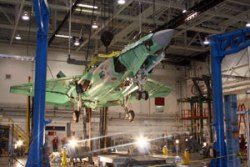Apr 13 2010
David Nelson recently piloted the F-35 Lightning II stealth fighter from Lockheed, which has incorporated the most comprehensive and powerful sensor package till date. Flown for the first time, the F-35 touched an altitude of 4,700 m.
 Lockheed Martin F-35 C Undergoes Tests
Lockheed Martin F-35 C Undergoes Tests
The fifth generation fighter integrates enhanced stealth with fighter agility and speed, completely fully fused sensor information, network-based operations, enhanced sustainment, and reduced operational and support costs. Lockheed Martin is working on the F-35 along with its major industrial partners, BAE Systems and Northrop Grumman.
The complete mission systems of the F-35 include an active array radar that is electronically scanned; an electro-optical targeting system; long-range passive, spherical threat detection; long-range, multiple simultaneous air-to-air and air-to-ground targeting; and a global positioning system.
The avionics of the F-35 is also capable of processing and applying data from a broad range of off-board sensors that are based at sea, air or land. This empowered the F-35 jet to conduct command and control functions and at the same time offer situational awareness for the surface and air forces.
During the flight, Nelson verified the functioning of the mission systems of the aircraft, conducted a range of quality drills and checked the response of the engine for various settings of the throttle.
The F-35 avionics has undergone laboratory testing in excess of 100,000 hours already. These tests include sensor-fusion testing for the Cooperative Avionics Test Bed program, a modified 737 airliner having the complete mission systems suite for the F-35, and the cockpit of the F-35. During the tests the F-35 software was very stable and the sensors matched and bettered performance estimates.
The Block 0.5 software offers critical capabilities that include navigation functions, synthetic aperture radar and air-to-air search and modes, integrated UHF/VHF radios, identification friend/foe transponder, and receiver for electronic warfare radar warning.
Enhanced helmet and cockpit displays present information to the pilot.
The F-35A customary takeoff and landing variant test aircraft and the F-35C carrier variant will also be equipped with identical mission systems. These mission systems for the three variant flights will have a commonality of 100%. Such avionics commonality facilitates interoperability, rapid training, and reduced production and support expenses.
As per schedule, the BF-4 will fly to the Md-based Naval Air Station where it will join the three other F-35Bs presently undergoing flight testing. The general test objectives of the BF-4 includes offering data to mission systems Block 0.5 functionality for the flight environment of the F-35 for analysis of the implementation and integration of hardware and software, thereby offering data for supporting component development in mission systems.